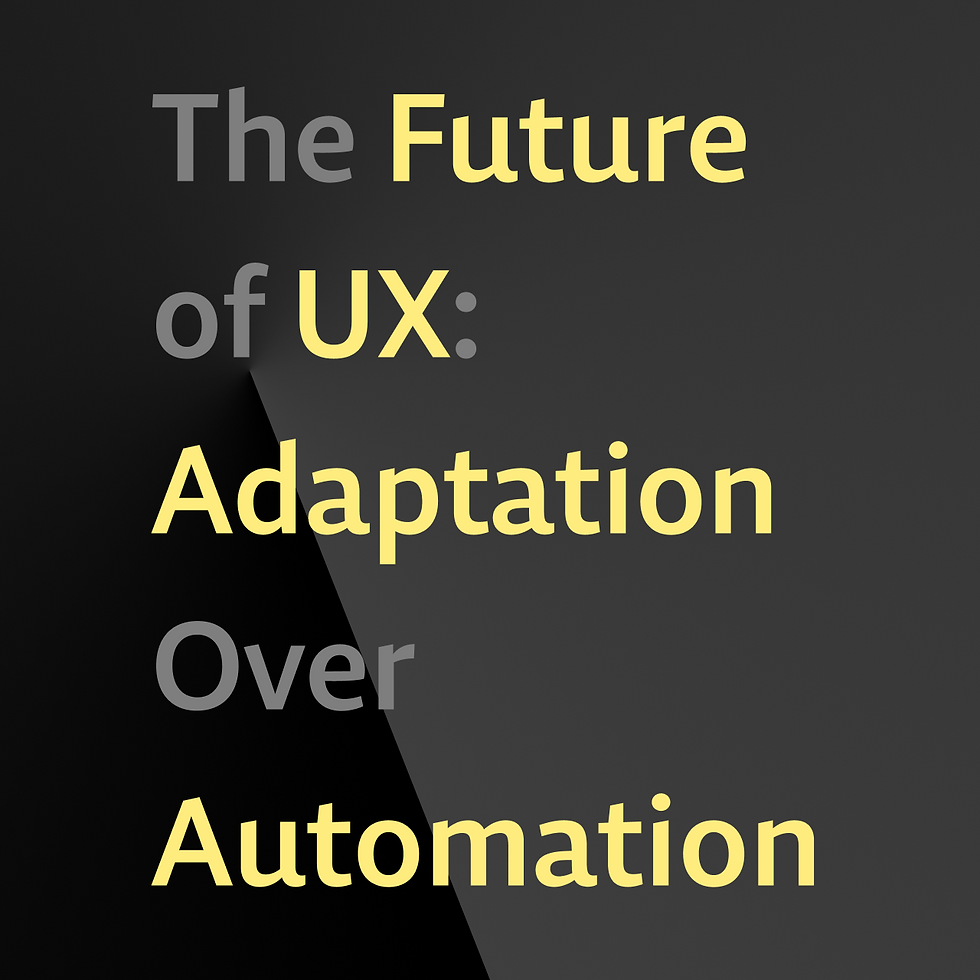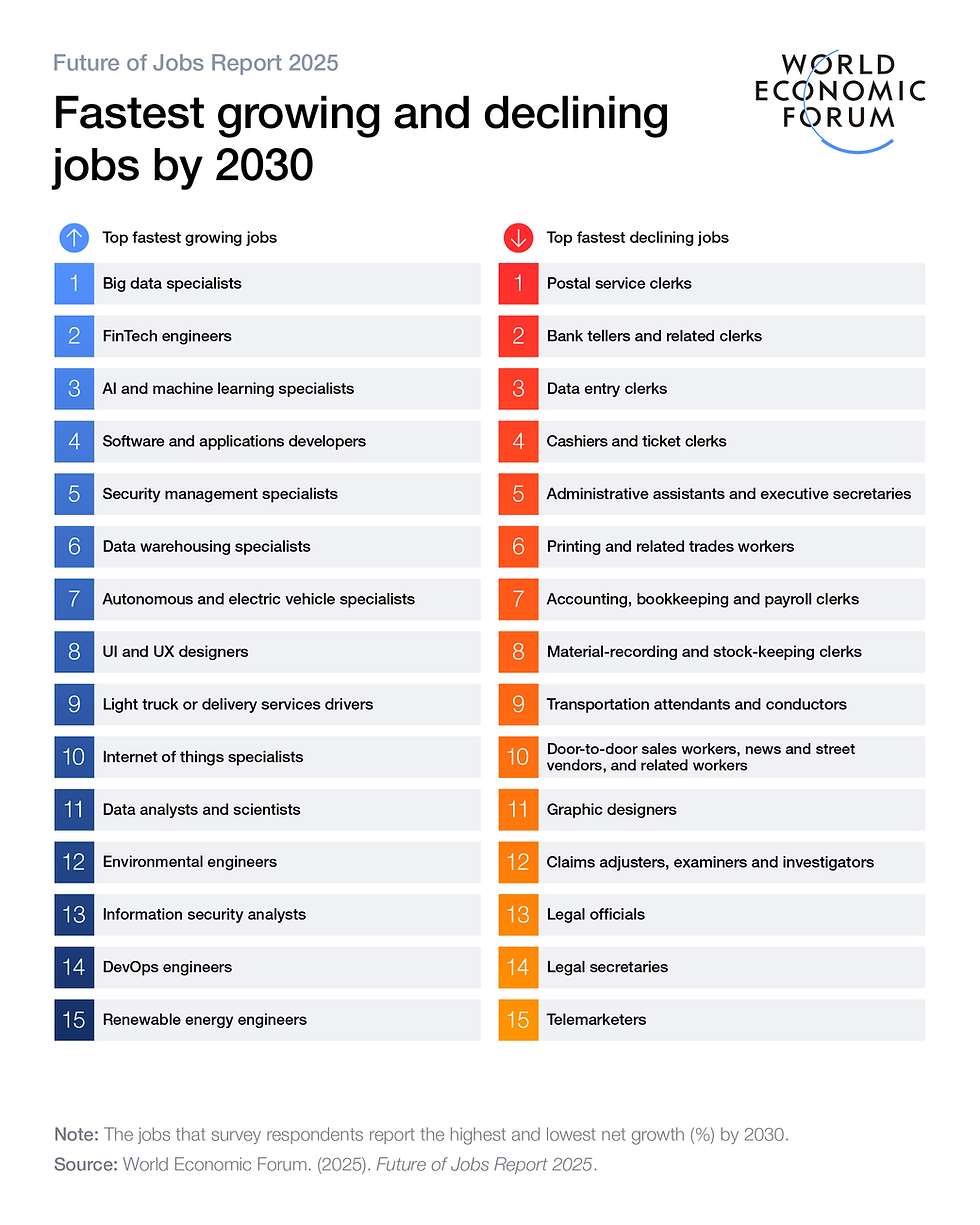The Future of UX: Adaptation Over Automation
- delarosbilt
- Feb 4
- 6 min read
In an era when technological advances are accelerating at a pace that can outstrip even the natural process of human aging, the field of UX and product design is undergoing a profound transformation.
Jakob Nielsen is a renowned pioneer in UX design with over 40 years of experience whose insights have shaped best practices across the digital world. In his UX Roundup for February 3, 2025, Nielsen highlighted how innovations—such as the rapid improvements in hearing aid technology—are not only extending human capabilities but also forcing professionals to reconsider their roles. He observed that while AI and automation are taking over many repetitive tasks, the true value lies in strategic interpretation and decision-making.
I share this vision: to remain relevant in the near future, UX and product designers must embrace AI tools like UX Pilot, which streamline routine work and free up time for creativity and strategic oversight.

Embracing AI Tools
UX Pilot is a groundbreaking AI tool designed to support the entire product design process—from ideation and brainstorming through wireframing, design review, and even preparing for user or stakeholder interviews.
As many designers have experienced, most AI tools based on large language models struggle with the visual nuances of UI design. They often require translating intentions into text, with the AI then interpreting this text into visual outputs that often miss the mark in usability or accuracy.
However, the UX process itself is deeply rooted in logic and narrative, which plays to the strengths of AI.
This is where UX Pilot truly shines.
Key Features of UX Pilot
Wireframe and UI Generation: UX Pilot enables rapid creation of both low-fidelity wireframes and high-fidelity designs using natural language prompts. The platform enhances prompts by automatically adding necessary components, ensuring comprehensive and well-structured design outputs.
Diagram and Flow Generation: The tool can automatically generate diagrams and user flows from selected designs or prompts, aiding in mapping out the overall user journey and ensuring consistent navigation across the project.
Design Review and Heatmaps: UX Pilot offers a design review feature that allows users to upload images for AI analysis. The platform can generate heatmaps to provide insights into potential usability issues, which are invaluable for optimizing user experiences.
Interview and Workshop Preparation: Beyond visual design, UX Pilot assists with the broader UX process by generating interview questions tailored to users or stakeholders. It also supports workshop facilitation by generating outlines and templates based on standard UX frameworks, streamlining team collaborations and planning sessions.
Interactive Editing: The platform allows for modifications of designs using natural language, making iterative changes faster and more intuitive.
UX Pilot offers a competitive package for designers looking to harness AI for both UI and, more importantly, UX tasks. Even if you primarily use it for enhancing your UX processes, the tool delivers tremendous value by automating repetitive tasks and giving you more time to focus on strategic, user-centered design.
UX Pilot exemplifies the future of AI-augmented design by addressing the shortcomings of traditional text-to-visual translation in AI tools. It leverages the strengths of AI in handling logic and structured data to support every phase of the UX design process, all while integrating seamlessly with the industry’s most popular design tools like Figma. This allows UX professionals to maintain creative control, improve efficiency, and ultimately, craft more meaningful user experiences.
Evolving Roles
Nielsen has long championed the idea that UX professionals need to evolve into “double experts”—adept not only in design but also in the industries they serve. I firmly believe that as AI tools like UX Pilot automate the low-level tasks of UX design, the competitive edge will shift to those who can effectively harness these tools.
Designers of the future must become strategic managers who are capable of “lifting AI”—prompting it, refining its outputs, and validating its suggestions. In this new paradigm, it’s not enough to simply generate a design; professionals must critically assess and iterate on AI-driven outputs to ensure they make sense in real-world contexts. This blend of domain expertise and strategic oversight is essential for turning raw AI-generated material into compelling, user-centered designs.
Both Jakob Nielsen’s insights and my own research emphasize a fundamental truth: while AI can handle a multitude of repetitive and operational tasks, it cannot replace the nuanced judgment and creative strategy of human designers. Nielsen’s reflections on how technology—such as improved hearing aids—can overcome natural human limitations serve as a powerful metaphor.
In the same way, UX Pilot automates the tedious aspects of design, giving us more time and mental space to focus on what truly matters: understanding our users, crafting innovative experiences, and ensuring that every design decision is aligned with business objectives. This parallel reminds us that the future of UX design is not about handing over the reins entirely to AI, but about integrating these tools to enhance our inherent human strengths.
Is UI/UX Design Really a Fast-Growing Field?
According to the World Economic Forum, UI and UX design are among the fastest-growing jobs projected for 2025–2030 (rank 8). Yet, despite this optimistic forecast, my experience suggests the current reality is quite different—there seem to be far more designers than available roles. A stark contrast to just a few years ago when demand outpaced supply.

This raises an important question: Is this projection a reliable indicator of future job opportunities, or just another broad, survey-based assumption? The WEF holds significant influence over global economic trends, but their reports don't always account for short-term shifts—such as the rise of AI-driven design tools like UX Pilot.
As automation and AI-assisted design continue to evolve, they are reshaping the landscape of design work. Tools like UX Pilot don't replace designers, but they streamline workflows, reducing the need for large teams to handle routine UX tasks. This could explain why job opportunities feel tighter than expected—businesses are increasingly adopting AI or at least exploring its potential, waiting for the green light to open new roles.
So, while the WEF’s long-term projections might still hold, the role of a UI/UX designer is changing. Adaptability and technical fluency in emerging tools like UX Pilot may become key to staying relevant in a shifting job market.
Deeper Into the Future
According to my research, the future of user interfaces may not be static screens but rather adaptive, intelligent systems. Agentic AI—where autonomous agents perform complex tasks dynamically—could pave the way for Adaptive UI (AUI). Instead of rigidly designed experiences, interfaces could morph in real time based on user intent, optimizing workflows on the fly.
A recent example of the future is You.com, an AI-driven platform that revolutionizes how users interact with information and digital tools. It combines AI-driven search with a ChatGPT-style chatbot, offering personalized recommendations and interactive experiences directly within the interface.
In this vision, we might move beyond isolated AI tools toward a unified platform where a single, versatile agent can handle various design, research, and development tasks. This shift could redefine the role of designers, enabling them to become AI generalists—crafting and guiding adaptive systems rather than just designing static screens and apps.
In Sum: The Future of UX: Adaptation Over Automation
As AI continues to reshape the landscape of UX and product design, one thing is clear: the future belongs to those who adapt. While AI tools like UX Pilot streamline processes and automate repetitive tasks, they do not replace the strategic, human-centered thinking that defines great design. Instead, they push designers to evolve—moving from pixel-perfect execution to higher-level decision-making and orchestration of AI-driven workflows.
The rapid integration of AI into design processes mirrors broader technological shifts, such as the emergence of Adaptive UI and agentic AI. As interfaces might become more dynamic and responsive to user intent, designers may find themselves less focused on static layouts and more engaged in shaping intelligent, evolving systems. This shift challenges traditional notions of UI/UX work and may redefine what it means to be a designer in the years ahead.
A colleague recently shared a perspective with me, comparing the future of design to the era before electricity, when a single person would manually light every street lamp. Once electricity replaced that task, it didn’t eliminate the need for work—it created an entire industry that employed millions. In the same way, as AI takes over routine design tasks, it will likely give rise to new roles and opportunities that we can't yet fully imagine.
The question is no longer whether AI will impact UX—it already has. The real challenge lies in leveraging these advancements to remain indispensable. The most successful designers of the future won’t just design interfaces; they might guide and refine adaptive AI systems, ensuring that technology remains aligned with human needs. In this new era, adaptability isn’t just an advantage—it’s a necessity. That's what The Future of UX: Adaptation Over Automation is all about.


Comments